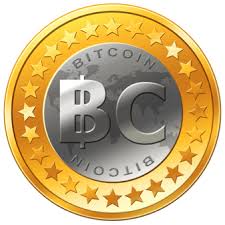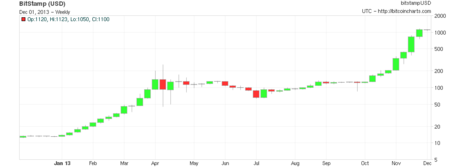 Bitcoin is the most well know Virtual Currency or Crypto-currency. It has gained in notoriety in the last year and has increased in value to the point that it was worth over $1100 per coin in November of 2013. Despite the cool picture to the left, Bitcoin is not a physical coin. It is actually just computer code. I will now try to explain in relatively simple terms what is Bitcoin and how it’s produced.
Bitcoin is the most well know Virtual Currency or Crypto-currency. It has gained in notoriety in the last year and has increased in value to the point that it was worth over $1100 per coin in November of 2013. Despite the cool picture to the left, Bitcoin is not a physical coin. It is actually just computer code. I will now try to explain in relatively simple terms what is Bitcoin and how it’s produced.
Bitcoin was created by a computer developer or developers in 2009. In essence it is a computer program which produces whats called a digital block containing codes for the Bitcoin themselves. This digital box is locked and the only way to open it and to access the Bitcoin code inside is to solve complicated equations. Powerful computing power, with a tangible cost in software, hardware and energy, is necessary to solve these equations and to open the Block. This process of opening the digital Block is actually called Bitcoin Mining. Miners vie for the opportunity to open the Block and gain access to the Bitcoins inside. Once the Block is opened and the Bitcoins inside are released a new Block is produced and the process begins anew. The system is designed that a new Block will be produced every 8 minutes. The amount of worldwide computing power used to open each block determines how difficult the equations will be to open the Block in order to ensure that one new Block is produced every 8 minutes.
According to the design of the program there will only be 21 Million Bitcoin produced with production ending in the year 2140. Every 4 years the number of Bitcoin released in each Block is cut in half. Two years ago there were 50 Bitcoin per Block; currently there are 25 per Block. There are now about 12 million Bitcoin in circulation. So as we see the ability to mine Bitcoin is becoming progressively harder and will require more and more computing power as more and more people get involved in the mining and the amount of Bitcoins released per Block reduces over time.
Bitcoin are stored in digital wallets which hold the information of each Bitcoin. The owner accesses his Bitcoin with a unique password. Each Bitcoin contains a digital track record of the transactions that the coin was involved with. It also contains the address of each digital wallet that held it.
The following is a typical example of a Bitcoin Address: 1JVtKo9NMtTwFehtycWrmYZjSL1UMkkdMQ
The price of Bitcoin is determined solely by the public marketplace. In 2011 it had it first extreme price fluctuation when it rose form $0.30 to a high of $32 before dropping to $2.
 2013 has been the year that Bitcoin has begun to gain recognition as a real currency. Many countries are classifying the virtual currency as real money subject to the regulation and taxation of other financial instruments. This level of confidence and acceptance has helped catapult the price of Bitcoin to unseen levels. From a price of $13.36 in January 2013 Bitcoin traded at a high of $1124.76 on November 29. At this point there are about 1000 “Brick and Morter” businesses and more than 20 online merchants that accept Bitcoin.
2013 has been the year that Bitcoin has begun to gain recognition as a real currency. Many countries are classifying the virtual currency as real money subject to the regulation and taxation of other financial instruments. This level of confidence and acceptance has helped catapult the price of Bitcoin to unseen levels. From a price of $13.36 in January 2013 Bitcoin traded at a high of $1124.76 on November 29. At this point there are about 1000 “Brick and Morter” businesses and more than 20 online merchants that accept Bitcoin.
It isn’t clear whether such high price levels can be sustained, but what is clear is that Bitcoin is now an accepted worldwide currency that will only gain in usage and popularity moving forward.


